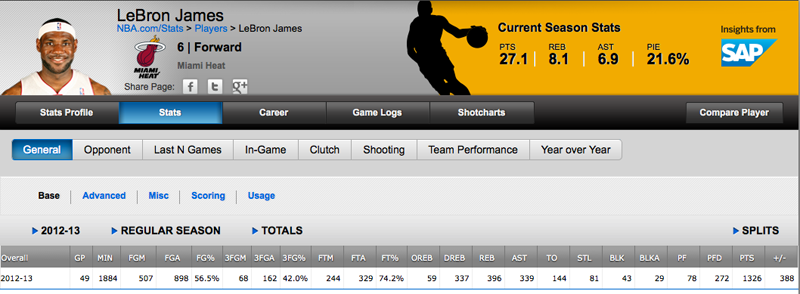
Advancing methodically, the NBA is embracing analytics and making them the new normal. This offseason footed the bill to install and run SportVU player tracking cameras in the remaining arenas that didn’t have them, institutionalizing complex data. Last month it made a portion of that data available to the public on NBA.com, letting the average fan look up which players run the furthest or rack up the most hockey assists during a game. On Monday it took another step forward and introduced video box scores. You can now click on any portion of a box score on NBA.com, like Steve Blake’s 11 field goal attempts, and a pop-up video player will show you short clips of all 11.
In contrast to other professional sports leagues, the NBA has long embraced digital. It was a leader in creating foreign language versions of the website to push into new markets, and has always embraced and encouraged its player’s social media presence, understanding that the occasional PR headache was worth the intimate connection with fans. Though the league probably won’t admit it publicly, it also turns a blind eye to intellectual property theft, which is why you can find numerous highlights, remixes and even whole games on YouTube.
At first glance, offering fans access to video box scores seems benign; it’s just another tool to get a few more of them hooked on basketball. But on a business front, it’s a brilliantly sneaky move.
Five years ago, the NBA announced a partnership with Synergy Sports Technology, a video-indexing technology company, to provide access to Synergy’s video to NBA TV and NBA.com. While it has been used on those platforms, it never made its way into the hands of the common fan, though you can (and many journalists do) buy a subscription to its services. The gritty details of the NBA’s partnership with Synergy has never been publicized, but it is clearly ongoing.
Offering video box scores for free, however, is a shot across Synergy’s bow. While video box scores don’t completely replicate Synergy—you can’t get video of a specific player’s pick-and-roll shot attempts or anything as specific—it does a lot of the same things, and there is no telling when the NBA will expand it. More importantly to the blogger-on-a-budget or the statistically savvy fan, it’s free. Whether this spurs Synergy to lower the price of its services, signals the end of its partnership with the NBA or something else entirely is unclear, but the NBA is a large new competitor in the video-indexing market.
That’s a big deal in of itself, but video box scores will also have a huge effect on video highlights. It is clear that fans want them easily and quickly available online, and until now the NBA has decided the best strategy for growth is not to hire an army of lawyer to send out DMCA noticed to amateur YouTubers, but rather let video of its athletes proliferate. Now however, the most expansive source of video isn’t YouTube but NBA.com.
Like the situation with Synergy Sports, video box scores aren’t a direct substitute for what is available on YouTube. You can’t click on a box score to find a compilation of the best dunks of the year or every single one of Kevin Love’s outlet passes. The video also won’t be accompanied by pop music tracks (which is probably an improvement actually). But now if you hear that Stephen Curry hit eight 3-pointers last night, instead of hoping to find a clip of it on YouTube, you can go directly to NBA.com and know the video will be available.
This seems to make sense from a business perspective. Instead of letting Synergy Sports and YouTube capture the subscription and ad revenues from fans seeking information about the sport, the NBA now is. There’s also a “rising tide lifts all boats” scenario here; even a year ago I rarely went to NBA.com and now I go all the time, and fans like me are presumably more likely to click on the “tickets”, or any other, section of the website. There are many, many entities that make money off the NBA, and the league has decided it wants a little bit bigger slice of that pie.
This also portends a potentially interesting discussion in the future. The NBA TV contract extends through 2015–16, but discussions are expected to ramp up in significantly once Adam Silver becomes NBA commissioner in a few months. Part of the current deal has Turner Sports running NBA TV and its associated League Pass product. If this trend towards in-housing previously leased services continues, will NBA TV and League Pass be part of a new television package or will the NBA decide it wants to run it? Perhaps Turner will continue running NBA TV, but the league will see how poor of a service League Pass is and decide it can do better. We can hope at least.
The NBA did not return a call requesting comment.

